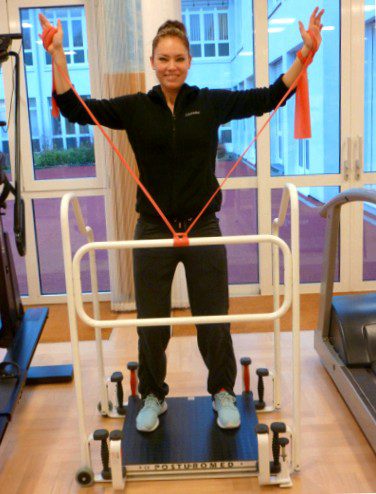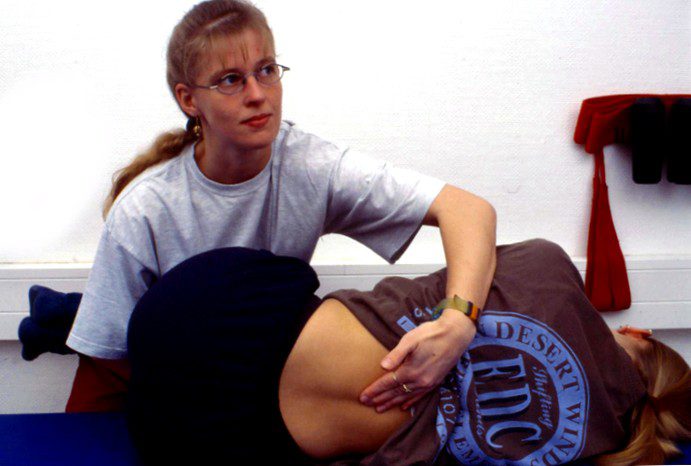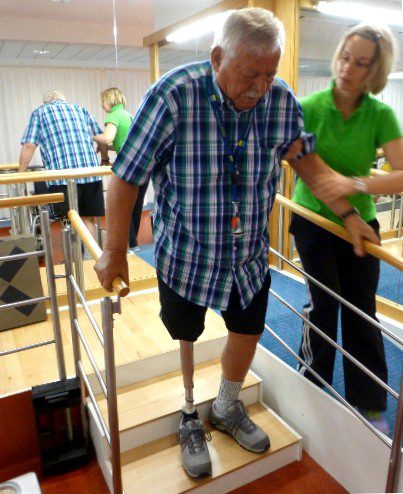Rehabilitation in orthopedics and trauma surgery
Rehabilitation as the third pillar of the health care system is becoming increasingly important. Due to the increasingly aging population, many sufferers experience functional limitations due to diseases and problems with the musculoskeletal system. Rehabilitation measures also support reintegration into everyday life after operations or accidents. The goals of rehabilitation are to maintain mobility and independence.
Rehabilitation is the important third pillar of the health care system (after prevention and treatment of illnesses and injuries) and aims to reintegrate the affected person as far as possible into independence, both at home and at work. Rehabilitate = restore, re-enable
Operating principle
It works on the principle of treating functional disorders. This refers to the fact that it is not only the actual diagnosis that is important, but rather the comprehensive treatment of functional disorders that restrict the affected person in everyday life, at work and in his or her private environment. These so-called participation disturbances must be eliminated. Personal, individual factors, but also the situation of the environment of the affected person play an essential role (for example, the support by relatives, the living situation, the mobility of the patient). The patient must therefore be cared for "holistically. Orthopedic rehabilitation continues to be one of the largest areas in the spectrum of all rehabilitation programs.
Areas of application
- Degenerative diseases of the musculoskeletal system (for example, spinal pain, degenerative changes in the large joints),
- Chronic musculoskeletal pain conditions (for example, chronic low back pain, CRPS, neuropathies, fibromyalgia)
- Operations and accidents (often endoprostheses, osteosyntheses, amputations, paralyses, tumor diseases)
- Metabolic diseases involving the musculoskeletal system (inflammatory rheumatic diseases, diabetes mellitus, osteoporosis, etc.).)
Implementation
In rehabilitation, treatment is multimodal, i.e. using different therapeutic approaches, in a multidisciplinary team working together. Such an approach has great advantages in the treatment of long-standing, chronic complaints or in the case of higher care requirements after surgical interventions or accidents.
Requirements for rehabilitation
Requirements for the granting of rehabilitation measures are a need for rehabilitation, sufficient rehabilitation capacity and a positive rehabilitation prognosis.
Need exists if the impairment relevant to everyday life is not only temporary, there is an impairment of the patient's participation in everyday life, and a multidimensional and interdisciplinary approach that goes beyond decorative care is required.
The ability to rehabilitate exists if the affected person has the necessary resilience, motivation or motivability to carry out medical rehabilitation due to his or her physical and mental condition. In recent years, the performance of rehabilitation facilities has massively adapted to the range of services offered by curative facilities, so that even early after operations and accidents, patients can receive excellent care.
Admission to the rehabilitation facility
Upon admission to the rehabilitation facility, the preliminary documents are first reviewed in the medical admission examination. This is followed by a detailed patient interview (anamnesis) with additional focus on a detailed pain anamnesis, an occupational and social anamnesis, but also an illumination of the psychological condition and the private environment. In addition to physical ability, an assessment of mental, social, spiritual abilities is important. Rehabilitation goals are then mutually agreed upon with the doctor and the treatment is arranged. The doctor coordinates the treatment tasks as a team in the further process.
After surgical interventions, more and more intensive care is required in rehabilitation due to the increasingly early transfers from acute hospitals. In addition to pain therapy and mobilization, this also includes skillful treatment in wound management.
Rehabilitation measures in orthopedics and trauma surgery
Classical treatment approaches of orthopedic rehabilitation are movement therapy (physiotherapy, sports therapy, occupational therapy), physical therapy (massages, heat and cold applications, electrotherapy, hydrotherapy, ultrasound, etc.), and physiotherapy.). This is accompanied by medical pain treatment (medication, injection therapies, manual therapy, acupuncture ), as well as measures from the field of technical orthopedics (prostheses, orthoses, shoe fittings, insoles).



This is accompanied by psychological care and interventions. After major surgery and accidents, for example, this can be post-traumatic stress disorder, in the case of chronic pain in the musculoskeletal system, there may be a secondary psychological impairment (often depressive mood) or there may even be a primary psychosomatic or mental illness, which manifests itself through complaints in the skeletal system. This is not uncommon. In the case of chronic back pain, it is assumed that significantly more than 50 percent of patients require treatment from this area.
Another important treatment approach is a detailed social counseling with initiation of accompanying measures. Here, supportive measures in the home area or vocational rehabilitation measures can already be initiated. Medically vocationally oriented rehabilitation (MBOR) is playing an increasingly important role in this context. Following medical rehabilitation or in parallel with it, patients can already be prepared for reintegration into the workplace with training that is close to the workplace.
Importance of rehabilitation
The importance of orthopedic trauma rehabilitation will continue to increase due to changing demographics. If we all want to experience an active third stage of life, the mobility required for this is playing an increasingly important role. As part of the aging process, reduced strength and coordination problems are major causes of falls, resulting illnesses and injuries, and ultimately loss of mobility and independence. Pain due to degenerative, wear-related changes also often leads to a loss of quality of life and independence. In this respect, orthopedic-injury rehabilitation has an important socio-political role to play.